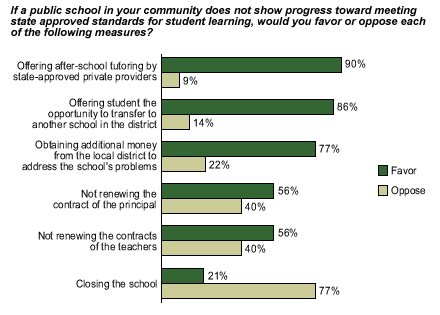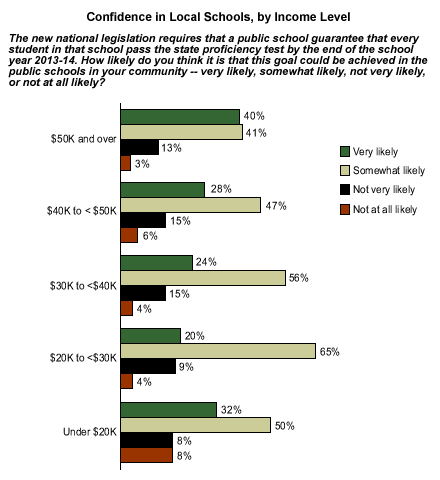This article contains findings from the 34th Annual Phi Delta Kappa/Gallup Poll of the Public's Attitudes Toward the Public Schools, the results of which were released today at the National Press Club. For more information on the study, visit www.gallup.com.
One of the things that differentiates the No Child Left Behind Act of 2001 (NCLBA), the education bill President Bush signed into law last January, from its 1994 precursor, the Elementary and Secondary Education Act, is that the new law has teeth. The NCLBA establishes consequences for underperforming schools that fail to improve, including transporting disadvantaged students to better schools.
The legislation also authorizes federal funding over the next six years, including $500,000,000 for fiscal year 2002, to help the states improve underperforming schools. Still, Education Secretary Rod Paige released a statement last month that reported that an estimated 8,600 schools currently fall into the "low-performing" category -- meaning parents of disadvantaged students at these schools can elect to transfer their kids out of them.
Ultimately, however, moving students to other schools may not be a long-term solution that Americans are comfortable with. The Gallup/PDK survey* indicates that Americans are very supportive of measures that expand opportunities for students, but are much less supportive of any option that they see as cutting off those opportunities -- especially closing underperforming schools.
Support for the Options
Respondents were asked what should be done if a school fails to meet state standards. Five of the six options were taken directly from the NCLBA. A majority of Americans approves of all but one option. Seventy-seven percent reject closing the school. The one option not mentioned in the NCLBA -- obtaining additional money for the school -- is supported by 77%.

Americans' responses to another question (what to do about teacher shortages) further illustrate their unwillingness to limit the quantity of educational opportunities available to students in the attempt to raise quality standards -- majorities oppose expanding class sizes (78%) and reducing the number of courses offered (61%); 93% favor using the most qualified teachers available instead.
Do Americans Fear School Closings in Their Own Communities?
Thus, even though 86% of Americans favor offering students the opportunity to transfer to another school in the district, that high level of support may not be sustained if the volume of transfers makes school closings commonplace. That possibility raises another concern: could closing underperforming schools mean that entire low-income areas would be left without public schools and have to transport kids to other districts?
Americans don't seem to be too concerned about that eventuality: four in five think the schools in their community will be able to pass the state proficiency test by the NCLBA's deadline, the end of the 2013-2014 school year. That belief holds up fairly well across income groups: 81% of Americans with an annual income of $50,000 and over think their schools are "very" or "somewhat" likely to meet that goal, compared to 85% of those with incomes between $20,000 and $30,000 and 82% of those with incomes under $20,000 (though those in the lower-income groups gravitate more toward the "somewhat likely" option). The optimism is not surprising given that Americans tend to rate the quality of education in their own local schools very positively, while at the same time rating the quality of public schools in the United States much more negatively.

That universal faith in local schools supports a comment Paige gave to the National Journal earlier this month: "Everyone thinks that there is some congruency between these blighted areas and school achievement. There is not. In the midst of some of the most at-risk communities you can imagine, we see some of the best schools, especially elementary schools."
Key Points
As federal and state education officials consider how to enforce the provisions of the NCLBA, they should be aware that Americans are likely to oppose any measure that they perceive will narrow the opportunities available to students, even in the name of quality improvement. Most Americans think the schools in their communities are capable of meeting the NCLBA's criteria, but even among those who don't think their schools would pass muster, measures intended to improve existing facilities are likely to be met with far greater support than those that lead to shutting them down and transferring their students elsewhere.
* These results are based on telephone interviews with a randomly selected national sample of 1,000 adults, aged 18 and older, conducted June 5-26, 2002. For results based on this sample, one can say with 95% confidence that the maximum error attributable to sampling and other random effects is ±3%. In addition to sampling error, question wording and practical difficulties in conducting surveys can introduce error or bias into the findings of public opinion polls.